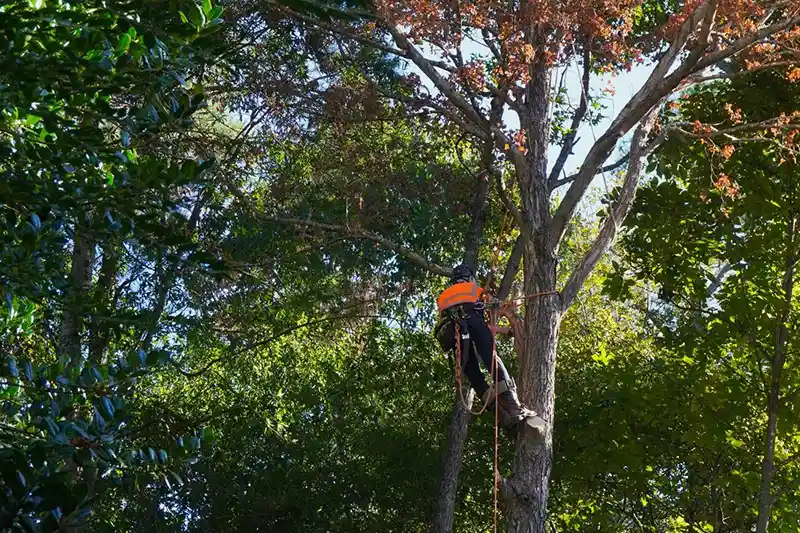We must assess our landscape for vulnerabilities, choosing wind-resistant trees and using strategic pruning techniques to ensure resilience against storms. Installing bracing and cabling reinforces tree stability, while proper soil care enhances root health. Post-storm, we inspect for damage like broken limbs and uprooted trees, prioritizing immediate hazards. Recovery involves pruning damaged branches, stabilizing leaning trees, and supplementing nutrients. By following these proactive measures and post-damage tree care practices, we can significantly reduce storm impact and promote rapid recovery, ensuring a robust and resilient landscape that mitigates future risks. There’s more to explore on each of these crucial aspects.
Assessing Your Landscape
Assessing your landscape is the critical first step in storm-proofing efforts. We need to conduct a thorough landscape evaluation to identify potential vulnerabilities. Environmental factors, such as soil type, drainage patterns, and wind exposure, play significant roles. First, let’s analyze the soil composition and stability, ensuring it can support tree root systems. Next, we should examine drainage patterns to prevent waterlogging, which weakens roots. Additionally, understanding wind exposure helps us determine which areas are prone to higher wind speeds. By systematically evaluating these environmental factors, we can create a comprehensive plan to mitigate storm damage. This proactive approach ensures we’re prepared, reducing the risk of significant damage during severe weather events.
Selecting Wind-Resistant Trees
When selecting wind-resistant trees, it’s crucial to consider both the inherent characteristics of the species and their suitability to your specific landscape conditions. First, we should prioritize native species, as they are naturally adapted to local weather patterns and soil conditions. Trees such as live oaks and southern magnolias are excellent choices due to their deep root systems and robust structure. Equally important is tree placement; planting trees in clusters can reduce wind speed and provide mutual support. Additionally, ensure sufficient spacing to allow for root expansion and stability. By combining thoughtful species selection with strategic placement, we can significantly enhance the resilience of our landscapes to withstand severe weather events.
Strategic Pruning Techniques
Pruning, a critical element of landscape management, demands both precision and timing to enhance a tree’s structural integrity and resilience to strong winds. Through strategic pruning techniques, we can optimize tree shaping and seasonal trimming to minimize storm damage.
– Removing Deadwood: Eliminating dead or decaying branches reduces weak points.
– Thinning the Canopy: Enhances airflow and light penetration, reducing wind resistance.
– Selective Branch Reduction: Shortening specific branches can balance weight distribution.
– Crown Raising: Elevating the lower branches aids in wind passage and reduces obstructions.
– Structural Pruning: Focuses on developing a strong central leader and scaffold branches.
Bracing and Cabling
Building on the foundation of strategic pruning techniques, we turn our attention to the advanced methods of bracing and cabling. These techniques provide essential tree support, enhancing storm preparedness. Bracing involves installing rods within the tree to reinforce weak branches and junctions. Cabling, on the other hand, utilizes high-strength cables to redistribute structural stress, often between the tree’s upper canopy and lower trunk. Together, these methods mitigate the risk of limb failure during extreme weather conditions. By strategically placing cables and braces, we prevent catastrophic failure that can result from heavy winds and rain. It’s crucial to consult with a certified arborist to ensure proper installation and optimal protection for our trees.
Soil and Root Care
Understanding the critical role soil and root care plays in storm-proofing our landscape can’t be overstated. Healthy soil and robust root systems are foundational to a tree’s resilience against extreme weather. To enhance soil aeration and root strengthening, we must adopt systematic practices.
– Aerate the soil: Regularly perforate the soil to improve oxygen flow and water absorption.
– Mulch application: Apply organic mulch to retain moisture and regulate soil temperature.
– Deep root fertilization: Inject nutrients directly into the root zone to bolster root health.
– Avoid soil compaction: Limit heavy machinery use around trees to prevent soil densification.
– Root barriers: Install barriers to control root spread and prevent structural damage.
Post-Storm Damage Inspection
After a storm, a meticulous post-storm damage inspection is essential for assessing and mitigating any harm to your landscape. First, we should carefully survey our property for storm debris, which can obstruct pathways and cause further damage if not promptly removed. During our damage assessment, we need to check for broken branches, split trunks, and uprooted trees. It’s crucial to document any signs of structural compromise, as these can pose serious safety risks. By examining the soil around tree roots, we can identify any erosion or instability caused by intense rainfall. This thorough inspection will enable us to prioritize immediate hazards and plan necessary interventions, ensuring our landscape’s resilience against future storms.
Recovery and Rehabilitation
During the recovery and rehabilitation phase, we’ll focus on revitalizing our landscape by addressing the damage identified in our post-storm inspection. To ensure our trees regain their health, we should follow a structured approach based on tree species and recovery timeline.
– Prune damaged branches: Remove broken limbs to prevent disease.
– Stabilize leaning trees: Use staking methods to support partially uprooted trees.
– Nutrient supplementation: Apply balanced fertilizers to promote root and foliage growth.
– Inspect root systems: Check for damage and compacted soil; aerate if necessary.
– Monitor for pests: Keep an eye out for insects that may exploit weakened trees.

